Boreal works with:
architects, property owners, facilities managers & renewable energy/sustainability executives. See a list of selected clients.
Boreal brings unique knowledge and resources at every stage of a project: From initial evaluation of wind and solar potential at your location through construction and operation of the optimal equipment. Here are a few of our projects.
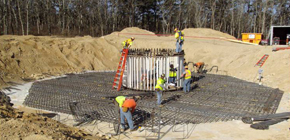
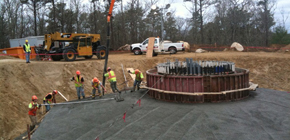
The owners of a Falmouth, MA industrial park parcel saw the potential in 2004 for a utility-scale wind turbine sited in a large, well-elevated location. A large turbine could supply electricity for the complex and create surplus power that could be delivered back to a regional utility. Despite receiving more than 100 letters of support from residents and businesses, the proposal required five years of local, state and other reviews before construction began. The property owners created a new corporation to generate electricity and coordinate with NSTAR, the local utility – helping NSTAR to increase its capacity from renewable sources and qualifying the venture for renewable energy certificates.
Client Need:
Commercial property owners wanted Cape Cod to develop renewable electricity sources and to capitalize on available clean energy grants .After a site evaluation that considered technical feasibility, permitting hurdles, forecasted production, and economic payback, Notus Clean Energy LLC moved ahead, selecting a turbine. The venture needed approvals from the Federal Aviation Administration, local zoning board and NSTAR. Then, Notus chose Boreal to manage installation from start to finish:
- turbine procurement,
- selection and oversight of construction firms,
- interconnection with the utility,
- complex metering arrangements,
- handling renewable energy certificates.
Solution: Wind Feasibility  Design/Build
Design/Build  Construction/Installation
Construction/Installation
Boreal began with a wind feasibility study, using computer modeling tools to predict wind patterns and directions, then evaluated turbine options. Notus chose a 1.65 MW, 262-foot-high installation for optimal generating capacity given site constraints. Boreal obtained necessary clearances from local, state, and federal agencies. This project, and a second turbine planned nearby, required a change in flight path for planes using nearby Otis Air National Guard Base. Acting as owner’s agent on the $4million project, Boreal worked with over a dozen firms from feasibility study through operation including electrical, civil and geotechnical engineers, legal counsel and even specialists in avian, sound and FAA issues.
Results
- Construction began in April 2010 and the turbine was online, generating electricity within four months – the shortest time from construction start to final commissioning of a utility scale turbine in Massachusetts.
- Boreal secured $875,000 in federal and state grants for this project and calculated a financial payback of less than five years from its in-service date.
Click here to see real-time data on Notus electric output.
Project Notes:
Notus Clean Energy is named for the Greek god of the southwest wind, the direction of Cape Cod’s prevailing summer breeze.
Each year of operation, the turbine’s clean power will avoid production of over 2,800 tons of carbon dioxide and five tons of sulfur dioxide, reducing regional air pollution and greenhouse gas emissions.
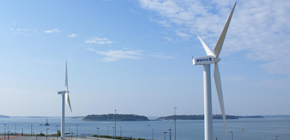
Massachusetts Water Resources Authority
(MWRA) – Boston and suburbs


 Wind, Solar, Consulting
Wind, Solar, Consulting
 Government
Government
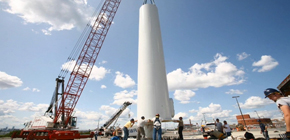
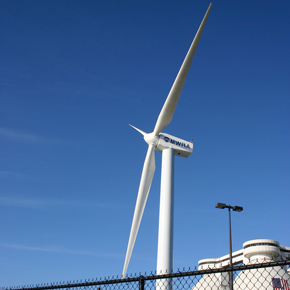
The MWRA is a state government agency that provides wholesale water and sewer services to 2.5 million people and more than 5,500 large industrial users. It also monitors outflows in Cape Cod Bay and Boston Harbor using a range of advanced technologies. As an industrial user of electricity, agency officials are looking to reduce economic volatility from electricity costs and to improve energy security by deploying renewable energy assets with inherent environmental benefits. More than 60 different communities rely on the agency for delivery of drinking water, managing drainage capacity and sewage treatment in an ecologically-sound way.
Client Need:
MWRA always seeks to reduce energy consumption and capitalize on its own sites for generating electricity and heat. MWRA officials wanted to evaluate solar and wind power generation potential at its pumping stations, treatment facilities and other sites. Boreal was retained both as a consultant and project manager to assist in a system-wide assessment of appropriate locations and technologies, and developing economic models for project cost and return-on-investment scenarios and project implementation assistance.
Solution: Consulting  Feasibility
Feasibility  Project management
Project management
Boreal was selected as an ongoing consultant to the agency, proposing renewable energy options at various locations. Our duties included defining project scope, goals and technical standards in creating Request For Proposal documents. We supported the evaluation of responses and the eventual selection of qualified bids for design and construction of photovoltaic and wind energy systems. After reviewing proposals, Boreal acted as owner’s agent for construction of a 1.5 MW wind turbine at the Charlestown, MA pumping station in 2011.
Results:
We have completed several solar energy feasibility and design projects. And we supplied business case analysis and design/build consulting for three different solar projects and two wind turbine installations through 2011.
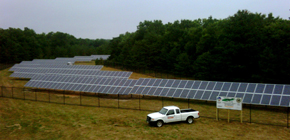
U.S. Department of Veterans Affairs - Calverton, NY
 Wind and Solar
Wind and Solar
 Government
Government
The U.S. Department of Veterans Affairs sought to build renewable energy at public facilities to reduce operating expenses and be more self-reliant. Boreal evaluated locations, recommended appropriate technologies to address energy demand, costs and aesthetic concerns. For Calverton National Cemetery on Long Island, the visitor center and public-area lighting is delivered by a 92-kW photovoltaic array.
Client Need:
Thousands of visitors and surviving family members every year pay respects to military veterans at national cemeteries. These facilities are expensive to operate with open space that includes parking, visitor center buildings, groundskeeping and security facilities. Federal real estate managers chose Boreal to evaluate the potential benefits and financial impact of renewable energy. Boreal was then chosen to provide the design of a photovoltaic (PV) system on the Calverton National Cemetery.
Solved: Wind/Solar Feasibility  Design/Build
Design/Build  Construction/Installation
Construction/Installation
For the Calverton cemetery, Boreal prepared custom designs of fixed-tilt and single-axis tracking PV solar systems, and compared the economics. Boreal eventually provided the final design of a 92 kW DC ground-mounted fixed-tilt PV system for construction. Working with partner Williams Construction Co., Boreal helped bring these two projects to completion, generating electricity.
Results:
The 92 kW PV system is generating over 110,000 kWh electricity annually. This was the largest ground-mount PV system in the VA system and advanced efforts by. Veterans Affairs towards energy efficiency goals consistent with Presidential Executive Order 13514 that sets out sustainability goals for all federal agencies.
Project notes
The federal government is the largest U.S. energy consumer, occupying nearly 500,000 buildings, operating more than 600,000 vehicles, employing more than 1.8 million civilians and purchasing more than $500 billion per year in goods and services.
Click here to see real-time data on Calverton electric output

Wellesley College – Wellesley, MA


 Wind, Solar, Consulting
Wind, Solar, Consulting
 Non-profit
Non-profit
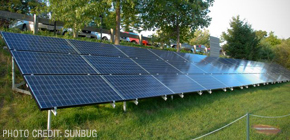
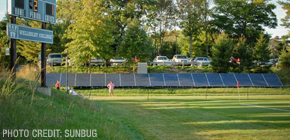
In 2008, college officials set four goals as sustainability priorities on this 500-acre campus, including initiatives to improve landscape, conserve water, reduce waste and energy use. A related project would create a "Green Center" near west campus athletic facilities, serving as a model for students and providing an ongoing educational resource. Classic red brick buildings and new facilities span a diverse property that includes wooded hillsides, lakes and an arboretum west of Boston. This renowned liberal arts college has welcomed undergraduate students since 1875 and is preparing its facilities for future generations.
Client Need:
Seeking to reduce fossil fuel energy use and to promote renewable energy options, Wellesley College contacted Boreal to evaluate campus locations for solar and wind installations.
Solution: Solar Feasibility  Design
Design  Installation
Installation
Boreal completed a feasibility study, economic analysis and a design plan for solar and wind technologies in 2009. For each site, we evaluated multiple solar and wind technologies and recommended the best options. Selections included:
- a concentrated solar thermal system for the trade shop building,
- grid-tied rooftop 110kW photovoltaic installation on the fieldhouse slopped roof,
- grid-tied ground-mounted 10.1kW photovoltaic array beside the soccer field, and
- a 50 kW wind turbine on a hilltop.
Wellesley officials chose the ground-mounted photovoltaic system as the first to be built. We finalized design of the PV system and prepared the bid solicitation documents, and provided construction oversight during the installation in summer 2010.
Results
This project quickly received all relevant regulatory approvals. Construction of the ground-mounted PV system was completed in one month, and completed in October 2010.
Click here to see real-time data on Wellesley College's electric output.
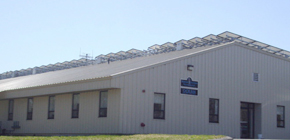
Float Realty Trust – Falmouth, MA
 Solar
Solar
 Privately Held
Privately Held
At an office/industrial park on Cape Cod, owners wanted to explore potential savings from rooftop photovoltaic electricity in a single-story industrial facility. In two of the facility’s buildings, people work daily designing and manufacturing scientific instruments for oceanographic research and monitoring of climate change. As a research institution, one of the main drivers for the project was to reduce greenhouse gas emissions through renewable energy use.
Client Need:
Seeking to capitalize on state grants and energy savings, FLOAT Realty Trust contacted Boreal to evaluate its metal rooftops. Most PV panels have to face south for maximum exposure to the sun’s daily travel. Yet FLOAT buildings faced east-west and had more limits because of nearby tree shading.
Solution: Solar Feasibility  Design
Design  Installation
Installation
Within a month, Boreal complete a feasibility study, design plan and economic analysis in late 2008. We provided a preliminary custom designed saw-tooth mounting structure on the east and west facing roofs that allow solar panels to face south for maximum exposure. Boreal also provided a preliminary design of a 78.54 kW solar system design. Working with an installation partner, we delivered a turnkey (design-build) grid-tied roof-mounted ballasted PV system.
Results:
This project quickly received all relevant regulatory approvals. It will recover the total cost of $620,000 within six years. Solar panels are warranted for 20 ears and the inverter has a 15-year warranty.
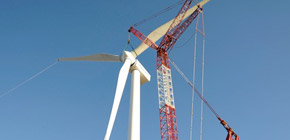
Philips Lightolier –
Fall River, MA
 Wind
Wind
 Privately Held
Privately Held
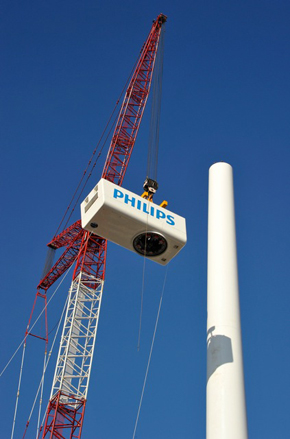
Founded in 1904, Philips Lightolier has long been an innovator in the electric lighting industry with its headquarters located in Fall River, MA. Philips Lightolier is a leader in the development of energy-efficient lighting and controls, from high performance fixtures, to smart controls, and the integration of electronics. New fixtures introduced by several different company brands achieve more than 90% efficiency in emitting the light output from the lamps they house. Lightolier also addresses sustainability in its own facilities. In addition to energy conservation measures and continuous improvement in product design and material content, they have made significant progress in improving manufacturing processes across the company. For example, at their headquarters in Fall River, MA, recent achievements include an 82% reduction in volatile air emissions, a 30% decrease in the use of toxic chemicals, and a 58% decline in toxic chemical bi-products.
Client Need:
In addition to the energy efficiency goals achieved in its manufacturing process, Philips Lightolier sought even greater success by implementing renewable energy sources to reduce its electricity load, as well as its carbon emissions. Philips Lightolier contacted Boreal to evaluate its site for a wind installation.
Solution: Wind Feasibility  Design
Design  Procurement
Procurement  Installation
Installation
Boreal completed a feasibility study, economic analysis and a design plan for a 2 MW wind turbine. As the project moved to the development stage, Boreal acted as owner’s engineer in procuring the turbine and construction contractor. Our duties included defining project scope, goals and technical standards for the project bid documents. We evaluated the bid responses from both the construction contractors and the turbine suppliers, and we managed the utility interconnection process.
Boreal also assisted Philips Lightolier submit and qualify for Federal and State grants. As a public-private collaboration, the state supported the project through two Massachusetts Clean Energy Center grants: $40,000 for the feasibility study and $500,000 for the design and construction of the turbine.
Results:
The 2 MW wind turbine is expected to produce up to 70 percent of the facility's electricity needs. In addition, the turbine will offset the production of nearly 30,000 tons of carbon dioxide over the lifetime of the project -- furthering the Commonwealth's nation-leading greenhouse gas reduction goals. In accordance with the Global Warming Solutions Act signed into law by Governor Patrick in 2008, Massachusetts must reduce greenhouse gas emissions by 25 percent below 1990 levels by 2020.
For more information on this project, please visit:
Click here for press announcement by Gov. Deval Patrick
Click here for article in SouthCoast Today
Click here for January 2012 WPRI-TV news video
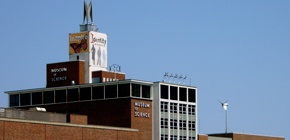
Museum of Science – Boston
 Wind
Wind
 Non-profit
Non-profit
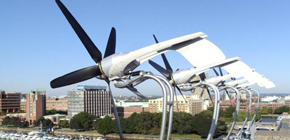
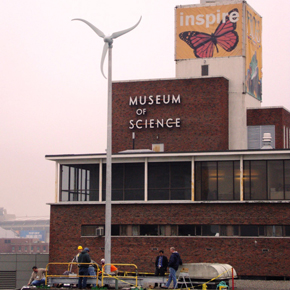
Each year, millions of visitors come to the Museum of Science – in Boston, only Fenway Park draws more people. This nationally-renowned center dates to the mid-1800s as a resource to teach and demonstrate how technology and science affects daily living. The museum enjoys a high-profile location along the Charles River, between Boston and Cambridge. Facilities include an IMAX theater and a 2 1/2 million volt Van de Graaff generator — the museum’s two-story tall high-voltage electrostatic display.
Client Need:
To evaluate the potential and capacity of rooftop wind power, the Museum of Science-Boston wanted to develop a “WindLab” and proposed installing five different types of turbines on its facility. Options ranged from a tall vertical axis turbine 30-feet-high – to a rack of five low-profile turbines side-by-side resembling airplane propellers. Finding the appropriate location for each size and type of installation required extensive study.
Solved: Feasibility  Design
Design  Installation
Installation
After initial meteorological studies to learn wind patterns, Boreal presented a plan for locating specific units and obtained zoning approvals from both cities. Engineers solved potential structural, noise and obstruction concerns for each turbine. In 2009, all five turbine installations were completed – with 13kW of wind capacity in total.
Results:
Built on-time and on budget in a difficult rooftop setting, within a few months of approvals, WindLab is a popular addition to the local skyline and is producing significant educational benefits and valuable data for the museum.
Click here for C|Net video of Boreal 2010 study

Varian Semiconductor Equipment Assoc. Inc. –
Gloucester, MA
 Wind
Wind
 Privately Held
Privately Held
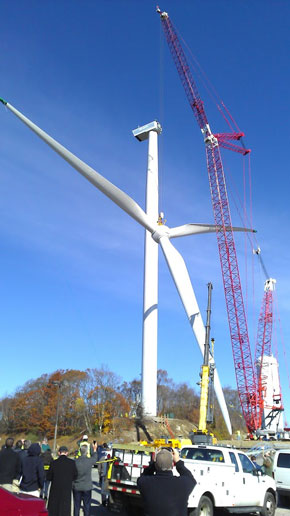
Producing the heavy equipment that makes semiconductors and other chips demands a tremendous amount of electricity, so this publicly-traded company sought ways to cut massive utility bills and pursue renewable power sources. Varian Semiconductor Equipment, a division of Applied Materials Inc., is located in an industrial park in Gloucester, MA. The Cape Ann hilltop location offered prospects for utility-scale wind turbines. In 2005, company officials studied the potential for two turbines that would reduce carbon emissions, reduce industrial stress on the regional electric grid, and secure a competitive advantage for office and manufacturing facilities that employ nearly 2,000 people.
Client Need:
Company officials engaged Boreal to perform a feasibility study that examined the site along with local electric demand, estimated growth and capacity issues. Varian Semiconductor also relied on Boreal to pursue grants and support from local economic development officials and analysis of economic payback. After securing regulatory approvals, Boreal selected the turbine equipment and oversaw the procurement process – estimated at ~$7 million - from start of construction to the start of electric generation:
- turbine procurement,
- selection and oversight of construction firms,
- interconnection with the utility,
- complex metering arrangements,
- handling renewable energy certificates.
Solution: Wind Feasibility  Design/Build
Design/Build  Construction/Installation
Construction/Installation
Boreal lead the wind feasibility study, using computer modeling tools to predict wind patterns and directions, and evaluated site and equipment options. Varian Semiconductor chose a 2.5 MW turbine manufactured by Kenersys, and Boreal obtained necessary clearances from local, state, and federal agencies. Over the course of the project, Boreal collaborated with more than a dozen firms from feasibility study through operation, including electrical, civil and geotechnical engineers, legal counsel and construction companies.
Results:
Boreal helped Varian Semiconductor obtain over $300,000 in federal and state grants for this project and calculated a financial payback of less than five years from its in-service date. It will supply about 34% of Varian’s electricity use, reducing the amount of electricity supplied by National Grid and related costs. Varian will use 99% of the power generated by the turbine on-site. It is expected the 2.5 MW turbine’s renewable electricity will result in approximately a 4,900 tons/yr reduction in CO2 emissions, greatly reducing Varian’s carbon footprint.
Watch the delivery, unboxing and installation of wind turbine at Gloucester, MA